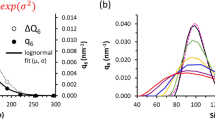Abstract
In this paper, we discuss experimental data obtained during study of the effect of a low-frequency alternating magnetic field on the conformational transitions of human serum albumin in the presence of silver nanoparticles using fluorescence spectroscopy at different pH values. A sharp increase in the albumin fluorescence intensity was detected in the presence of silver nanoparticles; this effect changed when exposed to a low-frequency alternating magnetic field. The resulting calculation formula for cross section of light scattering by a spherical nanoparticle of a certain radius allows calculation of the sizes of nano-microstructures based on nanoparticles and natural biopolymers of the “core–shell” type, whose physicochemical properties can be controlled by a magnetic field. The proposed model for the formation of protein–nanoparticle associates in the solution by the dipole–dipole mechanism is in good agreement with the experimental data.





Similar content being viewed by others
REFERENCES
T. Peters, Jr., All about Albumin: Biochemistry, Genetics, and Medical Applications (Academic, San Diego, 1996).
N. N. Pshenikina, Farmakologiya 12 (1), 1065 (2011).
G. Sudlow, D. J. Birkett, and D. N. Wade, Clin. Exp. Pharmacol. Physiol. 2 (2), 129 (1975).
J. K. Kamal, L. Zhao, and A. H. Zewail, Proc. Natl. Acad. Sci. U. S. A. 101 (37), 13411 (2004).
B. A. Noskov, A. A. Mikhailovskaya, S. Y. Lin, et al., Langmuir 26 (22), 17225 (2010).
Yu. A. Krutikov, A. A. Kudrinskii, A. Yu. Oleinik, et al., Usp. Khim. 77 (3), 242 (2008).
I. E. Stanishevskaya, A. M. Stoinova, A. I. Marakhova, et al., Razrabotka Registr. Lekarstv. Sredstv 1 (14), 66 (2016).
S. S. Dzhimak, V. V. Malyshko, A. I. Goryachko, et al., Nanotechnologies in Russia 14 (1–2), 48 (2019). https://doi.org/10.1134/S199507801901004x
A. A. Skirtach, A. A. Antipov, D. G. Shchukin, and G. B. Sukhorukov, Langmuir 20 (17), 6988 (2004).
A. Wang and Y. Cui, Chem. Asian J. 5 (8), 1780 (2010).
C. M. Dvorocek, G. Sukhonosova, et al., Langmuir 25 (17), 10322 (2009).
A. M. Yashchenok, Doctoral Dissertation in Mathematics and Physics (Saratov, 2016).
A. K. Zeinidenov, N. Kh. Ibraev, M. G. Kucherenko, Vestn. OGU 9 (170), 96 (2014).
E. E. Tekutskaya, M. G. Barishev, and G. P. Ilchenko, Biophysics 60 (6), 913 (2015). https://doi.org/10.1134/S000635091506024x
E. E. Tekutskaya, Russ. Open Med. J. 8 (2), e0202 (2019). https://doi.org/10.15275/rusomj.2019.0202
E. E. Tekutskaya, S. S. Dzhimak, A. A. Basov, et al., Med. News North Caucasus 10 (3), 287 (2015). https://doi.org/10.14300/mnnc.2015.10067
G. P. Il’chenko, M. G. Baryshev, E. E. Tekutskaya, et al., Measur. Techn. 60 (6), 632 (2017). https://doi.org/10.1007/s11018-017-1247-7
A. N. Gerasimov, Medical Statistics (Moscow, 2007) [in Russian].
I. M. Vlasova and A. M. Saletskii, Russ. J. Phys. Chem. B 3 (6), 976 (2009).
C. R. Bohreh and D. R. Huffman, Absorption and Scattering of Light by Small Particles (Wiley-VCH, 2009).
V. L. Ermolaev, E. N. Bodunov, and E. B. Sveshnikova, Nonradiative Transfer of Electronic Excitation Energy (Nauka, Leningrad, 1977) [in Russian].
Author information
Authors and Affiliations
Corresponding author
Ethics declarations
The authors declare that they have no conflict of interest. This article does not contain any studies involving animals or human participants performed by any of the authors.
Additional information
Translated by G. Levit
Abbreviations: HSA, human serum albumin; MF, magnetic field.
Rights and permissions
About this article
Cite this article
Tekutskaya, E.E., Baryshev, M.G., Tumaev, E.N. et al. The Effect of an Alternating Magnetic Field and Silver Nanoparticles on the Spectral Characteristics of an Aqueous Solution of Human Serum Albumin. BIOPHYSICS 65, 404–409 (2020). https://doi.org/10.1134/S0006350920030203
Received:
Revised:
Accepted:
Published:
Issue Date:
DOI: https://doi.org/10.1134/S0006350920030203




